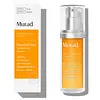What's inside
What's inside
 Key Ingredients
Key Ingredients

 Benefits
Benefits

 Concerns
Concerns

 Ingredients Side-by-side
Ingredients Side-by-side

Water
Skin ConditioningAlcohol Denat.
AntimicrobialGlycolic Acid
BufferingButylene Glycol
HumectantGlycerin
HumectantMethyl Gluceth-20
HumectantTranexamic Acid
Astringent4-Ethylresorcinol
AntimicrobialHexapeptide-2
BleachingRice Amino Acids
Skin ConditioningUrea
BufferingYeast Amino Acids
HumectantTrehalose
HumectantInositol
HumectantTaurine
BufferingBetaine
HumectantZinc Gluconate
Skin ConditioningDipotassium Glycyrrhizate
HumectantAllantoin
Skin ConditioningHydroxyethylcellulose
Emulsion StabilisingSodium Metabisulfite
AntioxidantSodium Sulfite
PreservativeSodium Hydroxide
BufferingPPG-26-Buteth-26
Skin ConditioningPEG-40 Hydrogenated Castor Oil
EmulsifyingPolyquaternium-4
Disodium EDTA
Limonene
PerfumingBenzyl Salicylate
PerfumingLinalool
PerfumingParfum
MaskingWater, Alcohol Denat., Glycolic Acid, Butylene Glycol, Glycerin, Methyl Gluceth-20, Tranexamic Acid, 4-Ethylresorcinol, Hexapeptide-2, Rice Amino Acids, Urea, Yeast Amino Acids, Trehalose, Inositol, Taurine, Betaine, Zinc Gluconate, Dipotassium Glycyrrhizate, Allantoin, Hydroxyethylcellulose, Sodium Metabisulfite, Sodium Sulfite, Sodium Hydroxide, PPG-26-Buteth-26, PEG-40 Hydrogenated Castor Oil, Polyquaternium-4, Disodium EDTA, Limonene, Benzyl Salicylate, Linalool, Parfum
Water
Skin ConditioningPropanediol
SolventLactic Acid
BufferingDiglycerin
HumectantSqualane
EmollientTriheptanoin
Skin ConditioningMandelic Acid
AntimicrobialTranexamic Acid
AstringentAlpha-Arbutin
AntioxidantGlycolic Acid
BufferingSodium Hydroxide
BufferingSilica
AbrasiveCoco-Caprylate/Caprate
EmollientSodium Polyacryloyldimethyl Taurate
Emulsion StabilisingNiacinamide
SmoothingSodium PCA
HumectantKojic Acid
AntioxidantBakuchiol
AntimicrobialNonapeptide-1
Skin ConditioningOligopeptide-34
Skin ConditioningCamellia Sinensis Leaf Extract
AntimicrobialGlycerin
HumectantCaprylyl Glycol
EmollientCetearyl Olivate
Sorbitan Olivate
EmulsifyingDilinoleic Acid/Butanediol Copolymer
Trisodium Ethylenediamine Disuccinate
Castor Oil/Ipdi Copolymer
Sodium Carbonate
BufferingEthylhexylglycerin
Skin ConditioningWater, Propanediol, Lactic Acid, Diglycerin, Squalane, Triheptanoin, Mandelic Acid, Tranexamic Acid, Alpha-Arbutin, Glycolic Acid, Sodium Hydroxide, Silica, Coco-Caprylate/Caprate, Sodium Polyacryloyldimethyl Taurate, Niacinamide, Sodium PCA, Kojic Acid, Bakuchiol, Nonapeptide-1, Oligopeptide-34, Camellia Sinensis Leaf Extract, Glycerin, Caprylyl Glycol, Cetearyl Olivate, Sorbitan Olivate, Dilinoleic Acid/Butanediol Copolymer, Trisodium Ethylenediamine Disuccinate, Castor Oil/Ipdi Copolymer, Sodium Carbonate, Ethylhexylglycerin
 Reviews
Reviews

Ingredients Explained
These ingredients are found in both products.
Ingredients higher up in an ingredient list are typically present in a larger amount.
Glycerin is already naturally found in your skin. It helps moisturize and protect your skin.
A study from 2016 found glycerin to be more effective as a humectant than AHAs and hyaluronic acid.
As a humectant, it helps the skin stay hydrated by pulling moisture to your skin. The low molecular weight of glycerin allows it to pull moisture into the deeper layers of your skin.
Hydrated skin improves your skin barrier; Your skin barrier helps protect against irritants and bacteria.
Glycerin has also been found to have antimicrobial and antiviral properties. Due to these properties, glycerin is often used in wound and burn treatments.
In cosmetics, glycerin is usually derived from plants such as soybean or palm. However, it can also be sourced from animals, such as tallow or animal fat.
This ingredient is organic, colorless, odorless, and non-toxic.
Glycerin is the name for this ingredient in American English. British English uses Glycerol/Glycerine.
Learn more about GlycerinGlycolic Acid is arguably the most famous alpha hydroxy acid (AHA) with tons of research backing its benefits.
It is found naturally in sugar cane but the form used in skincare is usually synthetic for purity and stability.
Glycolic acid removes the top layer of dead skin cells to allow newer and fresher ones to emerge.
AHAs work by breaking down the structural “glue” that holds old skin cells in place. When that buildup is gone, your skin can renew itself more efficiently.
Research also shows glycolic acid stimulates collagen production, helping to firm and thicken the skin over time. This is one of its biggest advantages over other AHAs.
Overall, glycolic acid helps with:
Fun fact: Glycolic acid boosts skin hydration by helping it produce molecules that increase hyaluronic acid naturally.
To work best, glycolic acid products should have a pH between 3-4 (that’s where exfoliation is most effective but still gentle on skin).
The pH and concentration of a product are key to its effectiveness:
It is normal to feel a slight stinging sensation when using glycolic acid. This usually fades as your skin adjusts.
Because glycolic acid has the smallest molecular size in the AHA family, it can penetrate deeper, which enhances its effectiveness but also makes it more likely to irritate sensitive skin.
If your skin is very sensitive or prone to rosacea, glycolic acid may be too strong; in that case, try milder options like lactic acid or a PHA instead.
Recent studies suggest glycolic acid might even help protect against UV damage. But don’t skip sunscreen! Freshly exfoliated skin is more sensitive to the sun.
Glycolic acid is a skincare superstar. It smooths, brightens, hydrates, and firms the skin. Unless you’re highly sensitive, it’s well worth adding to your routine.
Read more about some other popular AHA's here:
Learn more about Glycolic AcidSodium Hydroxide is also known as lye or caustic soda. It is used to adjust the pH of products; many ingredients require a specific pH to be effective.
In small amounts, sodium hydroxide is considered safe to use. However, large amounts may cause chemical burns due to its high alkaline.
Your skin has a natural pH and acid mantle. This acid mantle helps prevent harmful bacteria from breaking through. The acid mantle also helps keep your skin hydrated.
"Alkaline" refers to a high pH level. A low pH level would be considered acidic.
Learn more about Sodium HydroxideTranexamic Acid is best used for treating hyperpigmentation, discoloration, and melasma. It can also help build a stronger skin barrier.
Once applied, Tranexamic Acid starts decreasing inflammation from UV exposure. Tranexamic Acid also prevents our skin cells from meeting the pigment production cells.
Its brightening property makes it great at reducing the appearance of acne scars and marks.
Fun fact: Tranexamic Acid is also a medication used to reduce heavy bleeding.
This acid is derived from lysine, an amino acid.
Learn more about Tranexamic AcidWater. It's the most common cosmetic ingredient of all. You'll usually see it at the top of ingredient lists, meaning that it makes up the largest part of the product.
So why is it so popular? Water most often acts as a solvent - this means that it helps dissolve other ingredients into the formulation.
You'll also recognize water as that liquid we all need to stay alive. If you see this, drink a glass of water. Stay hydrated!
Learn more about Water